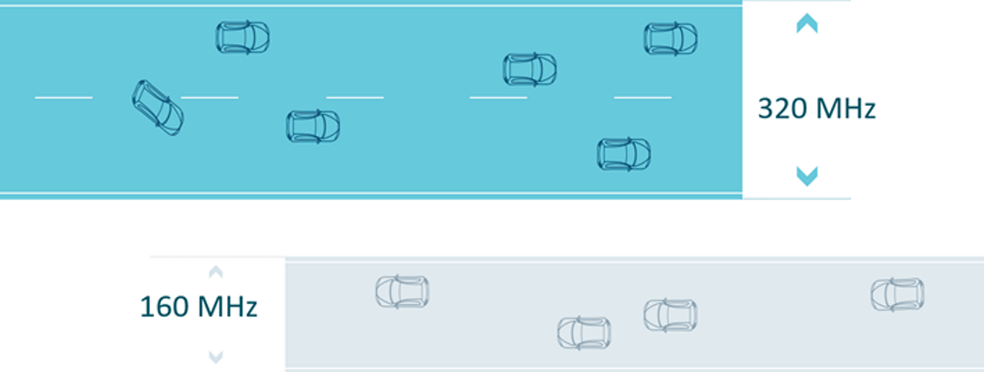How is Wi-Fi 7 More Advanced than Wi-Fi 6E?
From Wi-Fi 6 to Wi-Fi 6E to the latest Wi-Fi 7, network performance has witnessed tremendous leaps in progress. Both Wi-Fi 7 and Wi-Fi 6E represent the next generation of wireless networking. It’s worth comparing the two to see just how Wi-Fi 7 brings your home network to the next level.
What are Wi-Fi 7 and Wi-Fi 6E?
Wi-Fi 7 and Wi-Fi 6E are the two most recent generations of wireless standards. Wi-Fi 7, also known as IEEE 802.11be or extremely high throughput (EHT), is the latest Wi-Fi standard. Using the foundations built with Wi-Fi 6 and 6E, new technologies introduced in Wi-Fi 7, such as MLO, 4K-QAM, 320MHz Bandwidth, 16x16 MU-MIMO, and Multi-AP Coordination, work to deliver a higher data transmission rate with lower latency to your network.
Please Note: The number after “Wi-Fi” is not related to the bands or frequencies available, but rather the generation of wireless technology. For example, the 6GHz band was only made available in the Wi-Fi 6E standard and is not available with a Wi-Fi 6 Router.
Wi-Fi 7 Specific Features
With the added technologies and improvements over previous generations, Wi-Fi 7 is expected to support a throughput of up to 46 Gbps, about three times that of Wi-Fi 6E’s peak speeds.
| Wi-Fi 6 |
Wi-Fi 6E |
Wi-Fi 7 |
|
|---|---|---|---|
| Launch date |
2019 |
2021 |
2024 (expected) |
| IEEE standard |
802.11ax |
802.11be |
|
| Max data rate |
9.6 Gbps |
46 Gbps |
|
| Bands |
2.4 GHz, 5 GHz |
2.4GHz, 5GHz, 6 GHz |
2.4 GHz, 5 GHz, 6 Hz |
| Channel size |
20, 40, 80 80+80, 160 MHz |
Up to 320 MHz |
|
| Modulation |
1024-QAM |
4096-QAM |
|
| MIMO |
8×8 UL/DL MU-MIMO |
16×16 UL/DL MU-MIMO |
|
Multi-Link Operation (MLO)
To make efficient use of all available spectrum resources and minimize wasted communication, new methods of managing and coordinating the wireless spectrum of your network were added to the 2.4Ghz, 5GHz, and 6GHz bands. Most importantly, MLO, or Multi-Link Operation, was added to support multiple simultaneous links between your MLO-compatible devices and router, or between your mesh nodes.
Connecting to the 2.4 GHz, 5 GHz, and 6 GHz bands simultaneously increases throughput, reduces latency, and improves reliability. MLO is ideal for applications that require higher bandwidth and stable connections, such as online gaming, remote work, video calls, and cloud computing.
Read More: What is Wi-Fi 7’s Multi-Link Operation

Increased Bandwidth up to 320 MHz
Imagine your router’s Wi-Fi channels as roads and the data as cars on those roads. A channel’s bandwidth (80 MHz, 160 MHz, and 320 MHz) determines the size of the road i.e., the number of lanes. The more lanes you have, the wider the road, and the more cars (data) can travel at faster speeds with fewer jams.
An 80 MHz channel width could resemble a 2-lane neighborhood street, and 160 MHz a 4-lane road. This means the 320 MHz channel width of Wi-Fi 7 would look more like an 8-lane superhighway, allowing for more information transmission at the same time while freeing up heavier traffic.
- Wi-Fi 6E provided an additional 160 MHz channel in the 6 GHz band.
- Wi-Fi 7’s builds on this with 320 MHz bandwidth modes in the 6 GHz band, doubling the throughput compared with the 160 MHz of Wi-Fi 6.
Read More: Are Wi-Fi 7’s Ultra-Wide 320MHz Channels Worth It?

Higher-Order 4K-QAM
4K-QAM brings a higher data transmission rate and spectrum efficiency, essentially allowing for denser communications between your devices and router.
This is crucial for consistently communicating with a larger number of devices and ensures fast and reliable Wi-Fi coverage in high-density scenarios. This also allows you to easily watch 4K/8K videos with extreme fidelity and minimal buffering – all the while streaming or gaming.
- The highest-order modulation supported by Wi-Fi 6E is 1024-QAM, which allows each modulation symbol to carry up to 10 bits.
- Wi-Fi 7 further enhances the modulation order from 1024-QAM to 4096-QAM. This means each modulation symbol can carry 12 bits of data.
With the same coding, 4096-QAM can achieve a 20% rate increase compared with 1024-QAM in Wi-Fi 6E. We recommend reading the following article to learn how 4K-QAM dramatically increases the quality and stability of your connections.
Read More: Wi-Fi 7 Fundamentals – What is 4K-QAM
 More Streams and Enhanced 16x16 MU-MIMO
More Streams and Enhanced 16x16 MU-MIMO
Double The Streams, Double the Capacity
Wi-Fi 7 increases the number of spatial streams from 8 to 16, potentially doubling the transmission rate for previous generations.
To meet the growing traffic demands generated by the increasing number of Wi-Fi devices, Routers, and APs have continued to increase the number of antennas and improve simultaneous communication with multiple devices.
MU-MIMO technology can significantly increase throughput and reduce congestion and delays in crowded networks. This helps give each device high priority, allowing the whole network to maintain a fast and stable performance even when older, low-speed devices connect.
Read More: What is 16x16 MU-MIMO? An Intro to Wi-Fi 7’s Key Tech
Read More:
Wi-Fi 7 vs Wi-Fi 6: How is it Different?
What is Wi-Fi 7? An in-depth overview of the future of Wi-Fi

